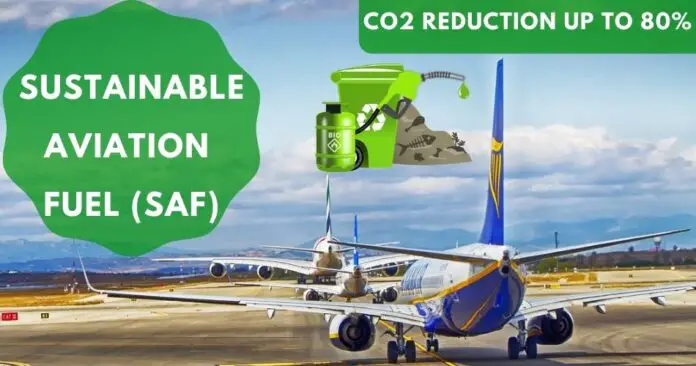Sustainable Aviation Fuel - Can It Curb Aviation Emissions?

As the world strives towards a more sustainable future, the aviation industry finds itself under increasing pressure to address its growing carbon footprint. With air travel demand projected to double by 2050, finding cleaner alternatives to traditional jet fuel is no longer an option but a necessity. This is where Sustainable Aviation Fuel (SAF) takes center stage, promising a greener future for air travel.
Understanding the Urgency: Aviation Emissions and Climate Change
The aviation industry contributes significantly to global greenhouse gas emissions. While it accounts for approximately 2.5% of global CO2 emissions, its overall climate impact is estimated to be higher due to the release of other non-CO2 emissions at high altitudes. These emissions contribute to global warming and necessitate a shift towards more sustainable practices.
According to the International Air Transport Association (IATA), in 2019, aviation emitted 915 million tonnes of CO2. This number is expected to rise significantly as air travel demand increases. The industry recognizes the need for change and has committed to achieving net-zero carbon emissions by 2050. This ambitious target requires a multi-pronged approach, with SAF playing a crucial role.
What is Sustainable Aviation Fuel (SAF)?
SAF is not a single fuel type but rather a broad term encompassing various renewable and low-carbon liquid fuels. These fuels are derived from sustainable feedstocks and offer a significant reduction in greenhouse gas emissions compared to conventional jet fuel.
Types of SAF Feedstocks:
- Used Cooking Oil and Animal Fats: These are currently the most common feedstocks for SAF, often referred to as HEFA (Hydroprocessed Esters and Fatty Acids).
- Municipal Solid Waste: Utilizing waste materials that would otherwise end up in landfills is a promising pathway for SAF production.
- Agricultural Residues: Crop residues like corn stover and sugarcane bagasse can be converted into bio-based fuels.
- Algae: Algae-based biofuels are gaining traction due to their high oil yield and minimal land use requirements.
- Direct Air Capture: This technology captures CO2 from the atmosphere and converts it into synthetic fuels, offering a potential carbon-negative solution.
Environmental Benefits of SAF: A Greener Flight Path
The primary advantage of SAF lies in its potential to significantly reduce lifecycle greenhouse gas emissions. Studies have shown that SAF can reduce emissions by up to 80% compared to conventional jet fuel, depending on the feedstock and production method.
Key Environmental Benefits:
- Reduced Carbon Footprint: The use of sustainable feedstocks and efficient production processes significantly lowers the overall carbon emissions associated with air travel.
- Improved Air Quality: SAF typically burns cleaner than traditional jet fuel, reducing particulate matter and other harmful emissions.
- Circular Economy Potential: By utilizing waste streams like used cooking oil and municipal waste, SAF promotes a circular economy approach, reducing reliance on fossil fuels.
Challenges and Opportunities: The Path to Widespread SAF Adoption
Despite the clear environmental benefits, several challenges hinder the widespread adoption of SAF. Addressing these challenges is crucial for unlocking the full potential of this sustainable alternative.
Key Challenges:
- Feedstock Availability and Sustainability: Ensuring a sustainable and sufficient supply of feedstocks for SAF production is paramount to avoid unintended consequences like deforestation or competition with food production.
- Production Costs and Scalability: Currently, SAF is more expensive to produce than conventional jet fuel. Scaling up production and driving down costs through technological advancements and policy support is essential.
- Infrastructure and Logistics: Adapting existing airport infrastructure and fuel supply chains to accommodate SAF requires significant investment and coordination.
The Future of SAF: Collaboration is Key
Transitioning towards a future where SAF powers our skies requires a collaborative effort from all stakeholders. Governments, airlines, fuel producers, and technology innovators must work together to overcome the challenges and accelerate the adoption of this crucial technology.
Key Actions for the Future:
- Policy Support and Incentives: Government policies can provide financial incentives for SAF production and use, creating a level playing field with conventional jet fuel.
- Research and Development: Continued investment in research and development is vital for improving SAF production technologies, exploring new feedstocks, and reducing costs.
- Industry Collaboration: Airlines, fuel producers, and technology providers need to collaborate closely to ensure a secure and sustainable supply chain for SAF.
Concluding Thoughts: A Greener Horizon for Aviation
Sustainable Aviation Fuel offers a viable pathway to decarbonize the aviation industry and mitigate its impact on climate change. While challenges remain, the collective efforts of industry stakeholders, policymakers, and researchers can pave the way for a future where SAF becomes the norm rather than the exception. By embracing this crucial technology, we can ensure that future generations can explore the world while safeguarding its future.













Comments ()